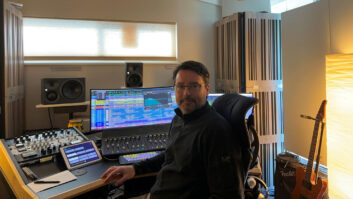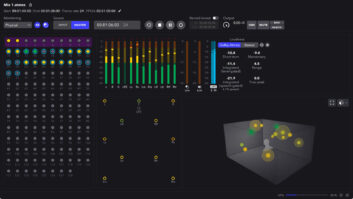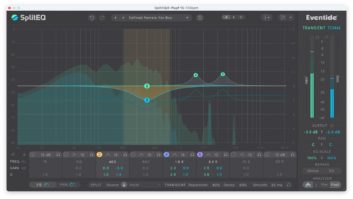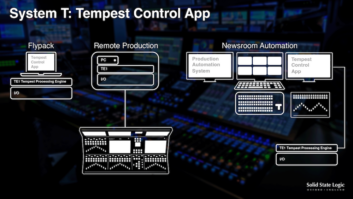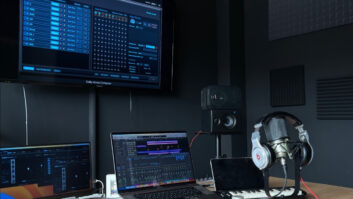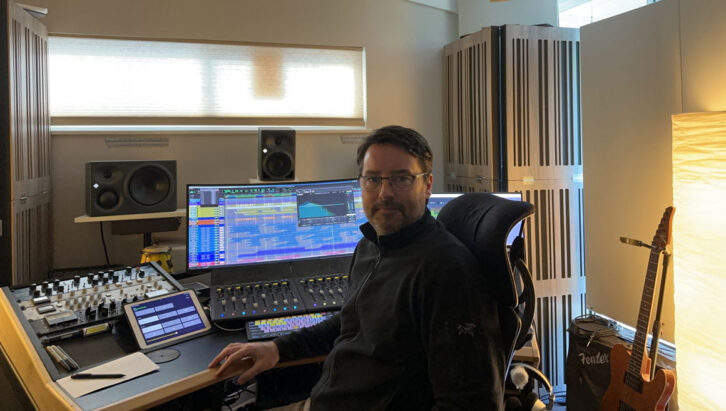
Los Angeles, CA, February 22, 2023 — As immersive and high-resolution audio has become widely available to consumers thanks to streaming platforms including Apple Music, Amazon Music, TIDAL, Spotify and others, talented mix engineers such as Kevin Madigan have been tapped for their expertise in creating compelling immersive mixes that maintain the character of the original stereo mixes, while expanding their sensory landscape.
Madigan is no stranger to immersive music, having worked as FOH on Santana’s acclaimed Las Vegas residency at House of Blues, the first of its kind Dolby Atmos Live experience. As far as recording studio-related work is concerned, he was asked by legendary mix engineer Manny Marroquin to help complete several immersive projects for artists including Migos, Kid Cudi, Portugal The Man and Kendrick Lamar among others at Larrabee Studio 3, which features an impressive Dolby Atmos 9.1.4 mixing set up.

Taking control with SplitEQ
While creating immersive mixes at Larrabee, one of the most important things for Madigan is to never lose the vision and integrity of Manny’s original stereo mix: “There are so many possibilities with immersive, but the idea is to expand the musical soundscape without ever being distracting,” he says. “There are so many placement possibilities and options to make it more interesting, but you can never lose focus of the original intent.” Madigan depends on many plug-ins in his workflow to arrive at exactly the sound he is looking for, and Eventide’s SplitEQ is most recently among these.
He has found SplitEQ particularly useful in his immersive productions since the percussive impact can change when moving from stereo to object-based mixing. “When you start spreading things out from traditional 2 bus with dynamic control, many things can change,” he says. “This is where transient control can really help, which is exactly what SplitEQ excels at. As mix engineers, we need to have tools available to us to maintain the character of that stereo mix.”
An innovation legacy in the world of plug-ins
“I’ve always been very familiar with Eventide’s legacy hardware, like the H3000 Ultra Harmonizer®-onwards — these were the thing to have,” Madigan says. “When Eventide got into the plug-in world, being able to access many of their products in the box was just great.” Indeed, he has been a regular user of several Eventide plug-ins including the H3000 Factory Ultra Harmonizer plug-in, the H910 Harmonizer Plug-In Suite and of course SplitEQ. “The modeling Eventide has done, including on the legacy hardware pieces, has been fantastic. It brings these tools into the modern world with Pro Tools and other platforms, and I can have more than one!”
He says that SplitEQ has taken things to the next level: “I really like being able to address whatever frequency range I like for transient control.” Since last year, Madigan has worked on immersive projects including Migos, Alessia Cara, Kid Cudi, Portugal The Man, Post Malone, Lizzo and Kendrick Lamar. Working on Lamar’s “Die Hard”, he recalls reaching for SplitEQ to maintain the impact of a drum loop that was foundational to the track: “In this loop, I wanted more control over the transients, but only in one specific frequency area,” he explains. “ SplitEQ helped me get the transient control I was looking for instantly — it was exactly what I needed and allowed me to quickly move on.”

SplitEQ in rotation
SplitEQ has been on rotation ever since: “It is a constant go to at this point, and I know it will work straightaway,” Madigan says. “It is such a versatile tool to be able to grab whenever I need it.” While his initial application has been primarily on percussive elements, he is anxious to use SplitEQ on other instruments, including vocals. “I could see how it would be very useful on vocals, and I’d like to experiment with it for making guitar and bass pop a bit more.”
Having immediate and concise visual feedback is important for Madigan while using any plug-in, and he says that SplitEQ delivers on this front: “The visual aspect of the user interface is really well done. Having started in the analog world and learning from there, my ears give me a reasonable grasp of where I want to get to pretty fast. The graphical feedback on SplitEQ helps me reconcile what I am hearing visually — for instance how wide or how narrow a band is that I may be manipulating.”
For Madigan, the bottom line for any tool in his studio workflow has to be expediency and efficiency. “The immediacy of being able to get to where I needed was really the difference for me on SplitEQ,” he concludes. “Our projects turnover so quick that the use of these tools needs to be as expedient and efficient as possible. SplitEQ was extremely usable straightaway and helps me achieve the results I need quickly.”
Currently, Madigan continues his work at Larrabee Studio 3, where he just finished mixing Paramore’s most recent album.
About Eventide
Since 1971, Eventide has remained at the forefront of recording technology. In 1975 they revolutionized the audio industry by creating the world’s first commercially available digital audio effects unit, the H910 Harmonizer®. Since then, their legendary studio processors, effects pedals, and plug-ins have been heard on countless hit records. Eventide is a registered trademark of Eventide Inc. Harmonizer is Eventide’s trademark for a device incorporating pitch change.
